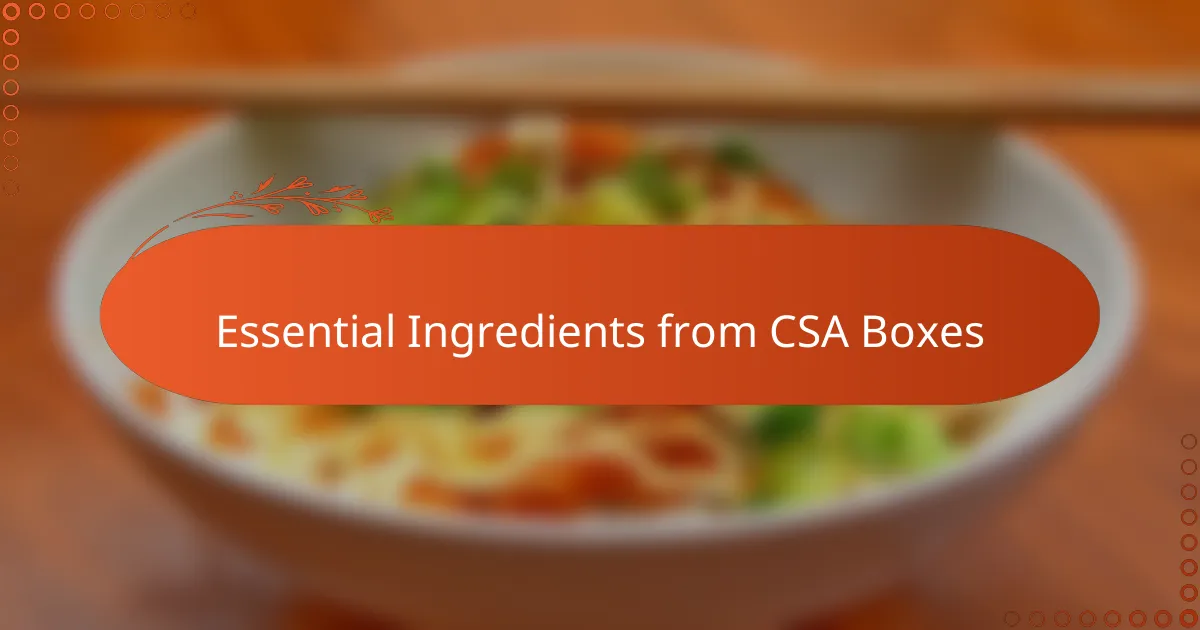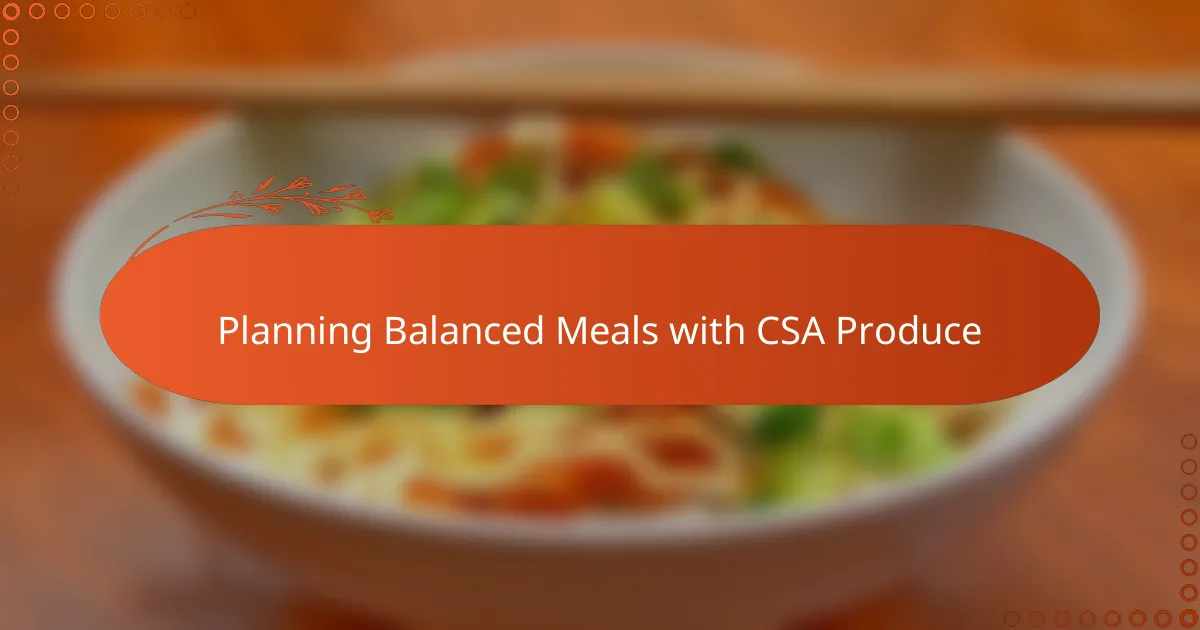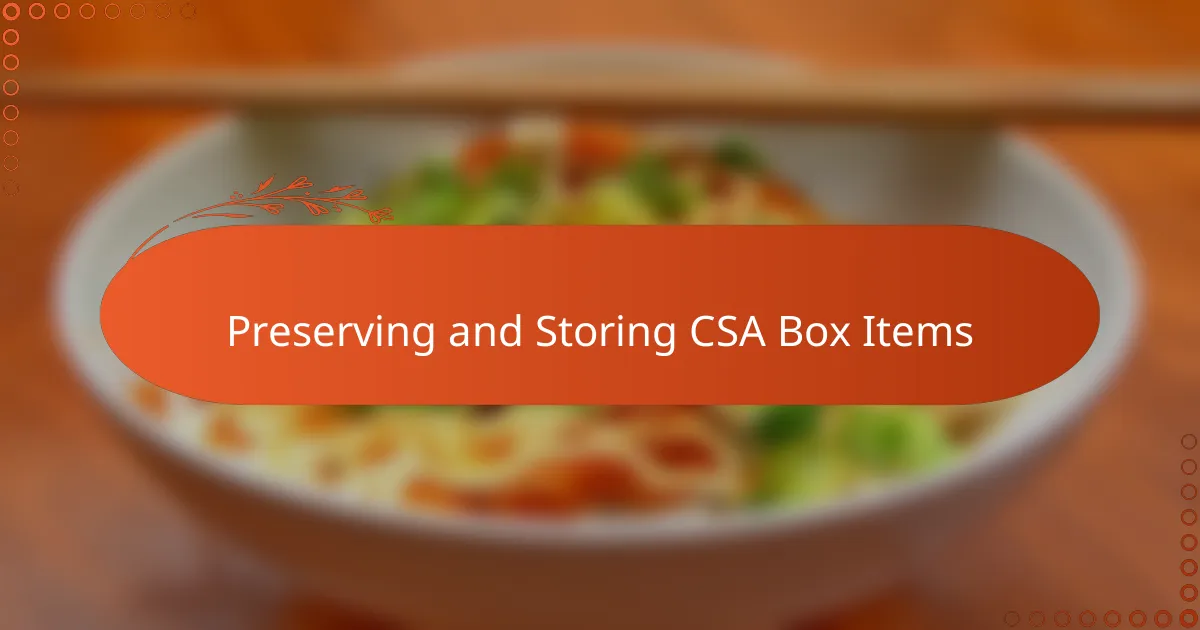Key takeaways
- CSA boxes offer a seasonal variety of fresh produce, encouraging creativity and adaptability in meal planning.
- Utilizing simple cooking techniques like roasting and steaming can enhance the flavors and textures of CSA ingredients.
- Planning meals around core ingredients while allowing for flexibility helps maximize the use of CSA produce and prevents repetition.
- Experimenting with raw preparations and preservation methods, like canning or quick pickling, adds excitement and extends the enjoyment of fresh produce.

Understanding CSA Boxes and Homesteading Meals
CSA boxes are a unique challenge and joy in homesteading cooking. When I first got mine, I stood staring at heaps of unfamiliar veggies, wondering how to turn them into more than just a salad. Have you ever experienced that sudden burst of inspiration mixed with a hint of overwhelm?
What makes CSA boxes special is their seasonality and surprise factor. Each week, I received whatever was at its peak, forcing me to cook creatively and embrace the rhythms of nature. This connection to the land, through the box’s contents, deepened my appreciation for fresh, local food like nothing else.
In essence, CSA boxes shape homesteading meals by dictating what’s on the menu, making me rethink planning and improvise with what’s on hand. It’s a dynamic dance between nature’s bounty and my kitchen skills, transforming cooking from a routine into a rewarding adventure.

Essential Ingredients from CSA Boxes
One thing I quickly realized is that some ingredients from CSA boxes became my kitchen’s backbone. Fresh greens, like kale or spinach, showed up almost every week, pushing me to find new ways to enjoy them beyond the usual sauté. Have you ever been surprised by how a simple bunch of greens can inspire a whole meal?
Root vegetables like carrots, beets, and radishes were another staple that anchored many dishes. Their hearty texture and natural sweetness added depth to stews and roasted veggie medleys, turning humble CSA finds into comforting homemade meals. I’d never thought such basic veggies could feel so satisfying until I worked them into my weekly cooking.
Then there’s the unpredictable charm of seasonal fruits or herbs tucked into the box. When fresh basil or juicy strawberries appeared, they felt like little gifts from the farm, urging me to whip up fresh pesto or spontaneous desserts. It’s these small delights that remind me why CSA ingredients aren’t just food—they’re a direct link to the land and the seasons.

Planning Balanced Meals with CSA Produce
Planning balanced meals with CSA produce quickly became a creative puzzle I looked forward to solving each week. How do I combine the leafy greens, vibrant root veggies, and unexpected fruits into dishes that satisfy both my taste buds and nutritional needs? I found that pairing a variety of textures and colors not only made meals visually inviting but also ensured a well-rounded balance of vitamins and minerals.
I remember one week when my box was bursting with kale, carrots, and some mysterious purple potatoes. Instead of defaulting to separate dishes, I decided to roast the potatoes and carrots while lightly sautéing the kale with garlic, then tossed everything together with a simple vinaigrette. That meal felt nourishing and complete, reminding me that balanced doesn’t have to mean complicated.
Sometimes the real challenge is figuring out how to stretch ingredients over several meals without feeling repetitive. I found that planning a core component—like roasted root vegetables—could easily transform from a dinner side one night into a hearty salad topping the next day. This kind of intentional planning turned the weekly CSA haul into a blueprint for wholesome, varied meals.

Preserving and Storing CSA Box Items
Storing CSA box items has become an art form in my kitchen. I’ve learned quickly that some veggies—like kale and spinach—are happiest when kept unwashed and cradled gently in perforated bags inside the fridge. Have you ever noticed how those delicate greens wilt if you try to rush them? Patience here makes all the difference.
Preserving root vegetables feels like a different story. I usually trim the tops, then store them in a cool, dark place or a humid bin in my fridge. It’s satisfying to watch how they hold up well over weeks, reminding me that a little care can stretch the life of humble carrots and beets far beyond that first meal.
Then there’s the thrill of preserving bounty through canning or freezing. Last summer, I turned a massive harvest of tomatoes into sauce jars that now pull me through the lean months. Isn’t there something deeply comforting about knowing a taste of summer waits quietly on the shelf whenever I need it?

Cooking Techniques for Fresh CSA Ingredients
When I first started working with fresh CSA ingredients, I quickly learned that simple cooking techniques like roasting and sautéing could completely transform the flavors. Roasting, for instance, brings out the natural sweetness in root vegetables and even gives leafy greens a crispy, caramelized edge that’s hard to resist. Have you ever been surprised by how a little olive oil and time in the oven can elevate humble veggies into something special?
Steaming and blanching also became my go-to methods for preserving the vibrant color and crispness of delicate greens like spinach or kale. I noticed that quick steaming keeps them tender without turning them mushy, which made salads and sides far more enjoyable. It’s a subtle skill that makes me appreciate the fresh texture of CSA produce even more.
Sometimes I like to experiment with raw preparations—think fresh salads, pestos, or quick pickles—to capture the immediate brightness of herbs and fruits from the box. There’s something deeply satisfying about tasting food as close to the earth and season as possible. Do you find that fresh ingredients cooked lightly or eaten raw bring a different kind of joy to your meals? For me, it’s a reminder of the simple beauty in every box.

Personal Meal Structuring Strategies
When structuring my meals around CSA boxes, I quickly realized the importance of flexibility. There’s no fixed menu when you’re working with a weekly surprise box; instead, I adapt based on what feels freshest and most inspiring that day. Have you ever found yourself reshuffling your plan after unboxing a vibrant bunch of chard or an unexpected fruit? That spontaneity keeps cooking exciting and deeply connected to the season.
I tend to build each meal around one or two star ingredients from the box, then layer in pantry staples to create balance and variety. This approach helped me avoid feeling overwhelmed, turning unfamiliar veggies into approachable dishes. For example, pairing roasted beets with familiar grains or adding CSA herbs to a simple soup gave me a sense of control amid freshness and creativity.
Another strategy that worked wonders was thinking about meals as a series rather than isolated events. When I cooked a big batch of roasted root veggies, I planned ahead for leftovers to become next-day salads or sandwich toppings. Turning the contents of my CSA box into multiple meals not only stretched my ingredients but made me appreciate the box’s bounty even more. Have you tried this kind of meal layering? It’s like giving every vegetable a starring role in your kitchen story.

Sample Recipes Using CSA Box Contents
One week, my CSA box arrived packed with tender zucchini, fragrant basil, and ripe cherry tomatoes. I whipped up a simple sautéed zucchini medley, tossing in fresh basil at the end to brighten the flavors, then finished it with a handful of toasted pine nuts. Have you ever been amazed at how a few fresh ingredients, handled gently, can turn into a dish that feels like a celebration of the season?
I also remember a week when beets, carrots, and kale dominated my box. Instead of seeing them as separate vegetables, I roasted the beets and carrots until caramelized and tender, then massaged the kale with lemon juice and olive oil to soften it. Combining these into a warm salad felt surprisingly hearty and comforting—a meal that really made me appreciate the textures and flavors nature offers when you let them shine.
Sometimes, the real magic happens when you think beyond the typical recipes. A box filled with unexpected radishes, spring onions, and fresh herbs inspired me to create a quick pickled radish relish, which lifted grilled chicken I made later in the week. It reminded me how CSA ingredients encourage me to experiment and find joy in the little culinary surprises they bring. Have you ever tried turning something ordinary into a flavor-packed delight just by changing how you use it?



